Black History Month All Year Long
Updated January 2024
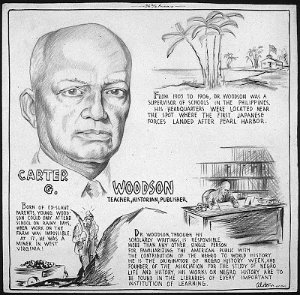
Historian Carter G. Woodson, along with colleagues at the Association for the Study of African American Life and History (ASALH), established Negro History Week in 1926. With mobs still lynching African Americans every year (335 deaths reported in the 1920’s, of the total 4400 from 1877 to 1950 documented by the Equal Justice Initiative) and a surge of race riots sweeping the country, Woodson wanted to provide a counterpoint to the racist perspectives that dominated America.
(For more on Woodson’s leadership and writings, see this 2022 Washington Post article by DeNeen L. Brown.)
Initially observed in black schools, churches and social organizations, the event grew into Black History Month (also known as African American History Month) with the US Congress designation of February as National Black History Month in 1986.
Since 1928 the ASALH has provided a theme for the annual observance. The 2024 theme is “African Americans and the Arts.” Looking over the thematic titles can provide students with a sense of the concerns of African Americans over the decades.
For example, the theme from 2006, “Celebrating Community: A Tribute to Black Fraternal, Social, and Civil Institutions,” can help students understand how African Americans, shut out of local and national organizations, developed their own fraternal, civic and social institutions, some of which fought violence against blacks — including the National Association for the Advancement of Colored People (NAACP) organized in 1909.
In 2014, ASALH celebrated the fiftieth anniversary of the passage of the Civil Rights Act of 1964. Find articles, videos and photos on the Act at History.com. The 1963 March on Washington which helped lead to the Civil Rights Act is explained in this National Geographic Kids article by Elizabeth Hilfrank. Another organization, BlackPast.org, celebrates Black History Month 2014 with a large collection of African American Firsts.
Freedom 159 Years Ago
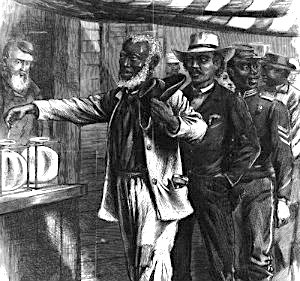
A Look at Selma 1965
In 2015 many media outlets recognized the 50th anniversary of the Selma March. Civil rights activists met violence in Selma, Alabama on March 7, 1965, as they attempted to walk from that town to Montgomery to protest a state trooper’s fatal shooting of Jimmie Lee Jackson, a young African-American demonstrator, days earlier and to further their voter registration efforts.
For contemporary New York Times reports, access PDFs in Michael Gonchar’s post for the newspaper’s Learning Network blog. There students can review the history of voting rights in the US, noting the US Supreme Court’s 2013 decision striking down part of the 1965 Voting Rights Act.
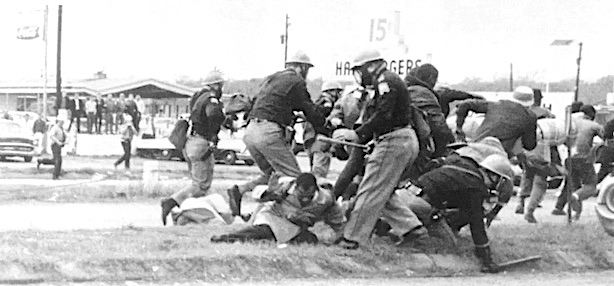
John Lewis (on ground, hand raised) was among the injured protestors for voting rights at Selma’s Edmund Pettus Bridge (March 7, 1965)
The National Park Service provides a lesson on Selma with background on Alabama actions to limit voting as well as images, activities and links to a wide range of resources. John Lewis, a US Congressman who served Georgia until his 2020 death, headed the Student Nonviolent Coordinating Committee and was injured during “Bloody Sunday” on March 7. The National Archives provides his court testimony requesting National Guard protection for a march that would begin March 21 and includes photos.
At MiddleWeb, Educators Respond to George Floyd’s 2020 Death
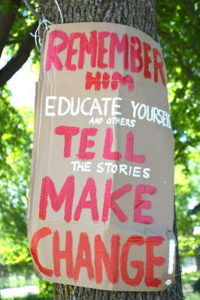
“Poster, George Floyd protest, Minneapolis, MN, June, 2020” by iamrenny. Public domain.
How can teachers help students understand the horror of unarmed Black individuals’ killings at the hand of law enforcement in the years leading up to George Floyd’s death? And how will classrooms change with that awareness? MiddleWeb bloggers and guest writers responded in the months following Floyd’s death.
In 5 Steps Toward Cultural Competence in Schools guest writer Dr. Vernita Mayfield wrote, “In the 21st century, there are precious few problems more urgent or essential than eliminating racism in schools, instituting equity in all school practices, and fostering a more culturally competent and responsive school workforce.”
The Chicago district where MiddleWeb blogger Lauren Brown teaches has wrestled with issues of equity centering around race with new urgency in recent years. Amid the pandemic and the rising Anti-Racist Movement, she believes part of the answer is deepening curriculum and teaching Black history throughout the year. In her post Shining the Light of Truth: Teaching Black History All Year Long she provided extensive resources.
Lauren joined our other history blogger, Sarah Cooper, in writing Teaching U.S. History in Turbulent Times, a three part series on information to include, awareness of the effects of the material on their students, and how they deal with difficult topics in their school community.
In response to the murder of George Floyd, people offered lists of actions to take to fight racism. MiddleWeb blogger Rita Platt added another: Get Anti-Racism Books Into Your Community. Read, talk and share. Help people deepen their understanding of white privilege and systemic racism. In her first blog post, written in the wake of Charlottesville, Rita shared Eight Ways Teachers Can Fight Hate & Injustice.
In her 2019 post, Breaking Out of the White Teacher Bubble Dina Strasser wrote that meaning well and teaching well are not the same – a painful truth that her exponential learning about race has helped her realize. She used the story of her unit based on Gary Paulsen’s “Nightjohn” to underscore the difference between intent and impact.
More Ideas for the Classroom
Writing in During Black History Month, helping students understand their role in history, teacher-author Jose Vilson shares a class discussion following the decision not to indict Darren Wilson for the shooting of Michael Brown and considers the value of Black History Month for his diverse students. His essay was written for the PBS Newshour and posted Feb. 18, 2015. Find many more of his posts here.
Learning for Justice, a project of the Southern Poverty Law Center, offers Why We Need Black History Month—Especially This Year with links to “Black History Month: Teaching the Complete History” and other articles. The Learning for Justice site also includes Do’s and Don’ts of Teaching Black History, Four Black History Month Must-Haves and Mining the Jewel of Black History Month (for a teacher’s evolution in bringing the month to class). The center also provides resources to help students understand implicit bias and systemic racism.
How Black Lives Matter Is Changing What Students Learn During Black History Month, a Time January 2020 article, reviews the development of Black History Month and how it has featured in the classroom. The article by Olivia B. Waxman reports on how curricula have been updated in some districts to give students a broader view of African American lives.
This Black History Month’s Lesson: Joy, a 2020 NYT article by A. Rochaun Meadow-Fernandez, is written for parents of Black children but offers insights to teachers from experts and other parents about helping children understand the joys and the challenges Black kids face.
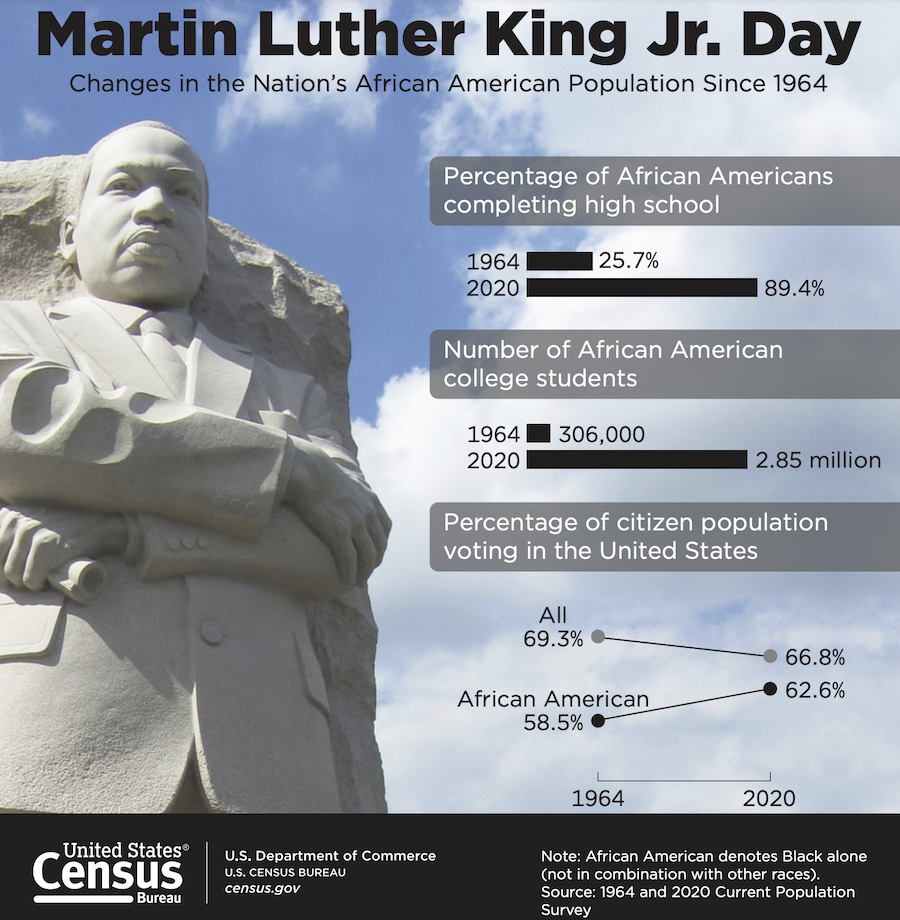
US Census source
Federal Collections
The Library of Congress offers teacher resources related to African Americans’ experiences and civil rights, arranged in periods from the 1700’s to 1996. LOC also offers Born into Slavery: Slave Narratives and African American Odyssey. To access several ready-made lesson plans rather than multitudinous resources, visit this LOC selection. Several lessons are suited for 6-8 graders.
The US National Archives website is a rich source on African American History with links to lesson plans, documents and exhibits, and more. The African American Heritage page offers videos as well as blog posts and subject portals.
In the website about its history, the US House of Representatives includes “Black Americans in Congress” which features profiles of the congressmen and women along with 7-12th grade lessons plans following these members’ participation in the House from 1870 forward. Civil Rights history is provided in oral histories, an outline of Amendments and legislation and other pages.
The US Census offers a snapshot of African American culture in the “Facts for Features” report prepared for Black History Month in 2024.
The Smithsonian can help teachers bring art into the study of Black History with its online exhibits and teacher guides here. In addition students can see how African Americans have viewed America through art in this exhibit.
Beyond the Smithsonian, check out media literacy expert Frank W. Baker’s MiddleWeb article on The Visions of Gordon Parks which links the photographer’s artistry to his revelations of the lives of African Americans.
Reading and Writing
For English/Language Arts involvement in Black History Month, READ WRITE THINK offers a page which centers on the month-long National African American Read-In. The RWT page also includes lesson plans and links to the PBS’ African American World.
Reading Rockets, a WETA website, offers video interviews of African American authors and illustrators along with annotated thematic reading lists, activities and links to a long list of resources. Included in the Smithsonian’s Black History Teaching Resources is a reading list of stories for students ages ten and up (following books for younger kids) assembled in 1996. CommonSense Media hosts an annotated list of awarding winning books written for the most part since 2005, arranged by reader age, including these for Black History Month.
To see how fiction and nonfiction writers and illustrators deal with the scarcity of records and other primary resources on Black history, watch School Library Journal’s February 1, 2024 webinar, Fact Finding and Black History. Authors Carole Boston Weatherford, Lesa Cline-Ransome and Amina Luqman-Dawson along with illustrator James Ransome recall their lived experiences as well as their research and then comment on how they reveal the cruel treatment of enslaved people in ways that children can understand. Terry Hong includes several middle grades books – both fiction and nonfiction – in her SLJ article, 25 Audiobooks for Black History Month and Beyond.
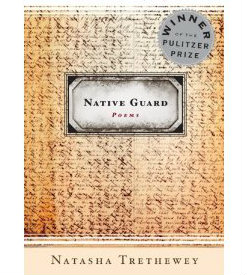
Trethewey links the Civil War to present day America in her poem, “Elegy for the Native Guard,’ remembering enslaved people and freedmen who enthusiastically served the Union. This link provides video of her reading the poem during a trip to Mississippi’s Ship Island where some of the Guard served. It features African American Native Guard re-enactors.
The first National Youth Poet Laureate, 2017’s Amanda Gorman, presented one of her poems “The Hill We Climb” during the Inauguration of Joseph Biden on January 20, 2021. In Adeel Hassan’s 2018 NYT article, “A Coda to Black History Month” she centers on Amanda Gorman and includes audio of her reading two poems.
The Poetry Foundation shares links to poems and essays by Black poets as well as articles and podcasts about them in a lengthy post.
Black Leaders in Math and Science
In this MiddleWeb article middle grades teacher Mona Iehl wants students to be able to “see themselves in math” and be represented in the work they do together. Learn how she uses the images and words of Black mathematicians to empower and inspire her classes to welcome and master math challenges.
To learn about lawyer Henry Bakers’ search for hundreds of Black inventors active but unknown in the late 1800’s and early 1900’s, read A casket holder, an airship and a list of pioneering Black inventors by Michael E. Ruane (February, 2023) in the Washington Post.
The HistoryMakers’ ScienceMakers offers biographies arranged alphabetically. Teachers could adapt one aspect of the Sciencemakers page: encouraging students to create speeches or videos imagining themselves as future scientists or as scientists of the past or present. HistoryMakers also provides biographical sketches of leaders in many other areas of expertise.
For students interested in space travel, NASA provides brief bios of current and past black astronauts. In 2011 Leland Melvin, a former astronaut who also worked as an engineer, chemist, musician, NFL player, and NASA educator, explains the history of African Americans in flight. In a 2015 NPR “My Big Break” interview, Melvin recalls his journey to becoming an astronaut and being part of the team taking the US into space.
Debating Black History Month
A 2023 Axios article, Black History Month arrives as teachers’ fears mount by Russell Contreras and Keldy Ortiz, looks into the challenges teachers continue to face as red states pass legislation limiting what can be taught about African American experience.
Black History Month’s place in education has faced debate on a number of fronts over the years. A recurrent discussion among educators and other Americans is whether racial and ethnic groups – African Americans, Latinos and Asians, for example – should be singled out for annual observations of their cultures. In Lauren Brown’s post, Shining the Light of Truth: Teaching Black History All Year Long, above, she shows how Black history is essential to American history classes year round.
In Black History Month Has Been an Epic Failure, a 2013 Huffington Post article, journalist Dion Rabouin faults teachers and proponents of Black History Month in the United States for failing to heed Malcolm X’s message: “Our history did not begin in chains.” Rabouin goes on to recount many great achievements by Black people in world history which he contends are given short shrift in American history lessons.
In 2016 MSNBC reported on a range of opinions on the value of Black History Month from Black and White Americans. Also that year in Black History Month in Schools—Retire or Reboot? Melinda D. Anderson wrote in The Atlantic about opinions on both sides of the debate and interviewed Black adults about their experiences of Black History Month in school.
More Valuable Resources
Middle grades students can discover local Black leaders with ideas from Sarah Elia’s 2024 article Using Place-Based Learning to Celebrate Black History in Elementary School.
Common Sense provides Free Learning Resources for Black History Month (And Beyond), a lengthy list of options including CommonLit’s searchable compilation of key moments in Black history.
iCivics’ Black History webpage links to lessons, videos and much more with topics ranging from women leaders and court cases to an overview of Civil Rights struggles.
The NEA has brought together a wide range of perspectives in its Black History Month webpage. Find items arranged by age group and format.
June 19, 2024 will be the fourth celebration of Juneteenth as a federal holiday. AP’s Kevin Freking reports on President Biden signing legislation recognizing Juneteenth in 2021 here.
In 2019 the Washington Post offered image collections with brief descriptions of notable African American firsts in the arts, politics and sports along with entrepreneurs and inventors.
The New York Times Learning Network provides a collection of resources, Celebrate Black History Month. It includes free access to historic front pages, news stories, lesson plans, and lots more. There’s also Learning With the ‘Black History, Continued’ Series from 2022.
For a video and lesson plan about the Underground Railroad and abolitionists, visit Scholastic.
PBS has curated a 2024 collection of programs to celebrate Black History Month. Two videos that could be used with middle graders concern gospel music and the debate around reparations.
For more, visit Larry Ferlazzo’s posts on websites to teach and learn about Black history here, videos included.
Art and photo credits:
Carter G. Woodson: US Office for Emergency Management. Office of War Information. Domestic Operations. Branch. News Bureau. (06/13/1942 – 09/15/1945)
Selma: Library of Congress, Prints & Photographs Division, NYWT&S Collection, LC-USZ62-1277321st
Vote for African Americans: Waud, Alfred R. (Alfred Rudolph). “The First Vote.” Nov. 16, 1867, from Harper’s Weekly. Prints and Photographs Division, Library of Congress.
Underground Railroad: Library of Congress, Prints & Photographs Division, [reproduction number, LC-USZ62-28860]
Evening Attire: James VanDerZee (1886–1983), Evening Attire, 1922, gelatin silver print, 10 x 8 in., Smithsonian American Art Museum
Leland Melvin: NASA/Carla Cioffi

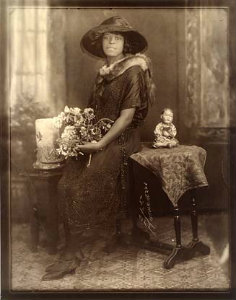
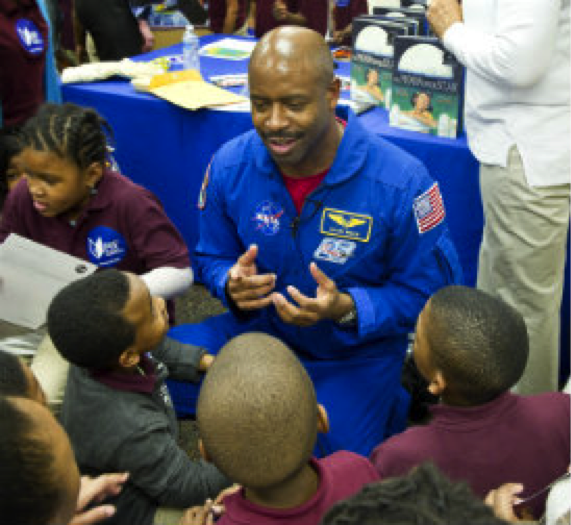































There is an excellent profile/ interview with CBS News reporter Bill Plante (from CBS’ 60 Minutes & 60 Minutes Overtime, 2/8/15). Plante was a young reporter for the network when he covered Selma. In the profile, he reads from his original TV news scripts and comments on the time period. URL:
http://www.cbsnews.com/news/5-days-50-miles-the-march-that-changed-history/
Yes, thank you for the lessons that I have been searching for all year. I have been wanting to plan more Black History into my lessons all year long and now I have so many resources to choose from.